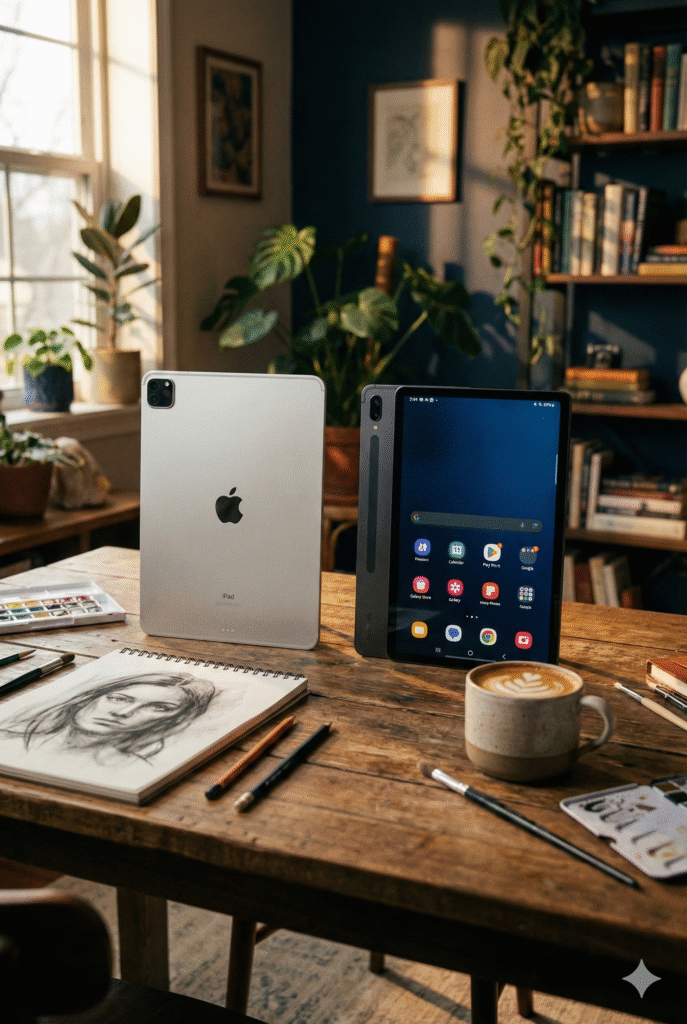The Clash of the Titans this Late 2025: Precision vs. Canvas
As we close out 2025, the tablet market has solidified into a binary choice between two distinct philosophies. On one side, we have the freshly released iPad Pro 13-inch (M5), Apple’s latest silicon marvel released just last month. On the other, the Samsung Galaxy Tab S11 Ultra, which dropped in September with a gargantuan footprint and a surprising shift in silicon strategy.
For us engineers, the headline isn’t just the screens—it’s the engines driving them.
Silicon Warfare: M5 vs. Dimensity 9400+
The most significant deviation this year is Samsung’s move to the MediaTek Dimensity 9400+ (4nm), stepping away from its exclusive Snapdragon partnership for the Ultra line. In our benchmarks, the 9400+ is a multi-core monster. Its “all-big-core” architecture pushes raw throughput that finally rivals Apple in sustained multi-tasking scenarios, specifically when juggling DeX windows and rendering background exports.
However, Apple’s M5 chip (Nona-core CPU/10-core GPU) retains the crown for single-thread efficiency and burst performance. For developers compiling code or designers applying complex vector filters, the M5’s “snap” is imperceptible but statistically superior. The M5 also introduces an updated Neural Engine that local LLMs (Large Language Models) run on roughly 15% faster than on the previous M4, a crucial edge for on-device AI workflows.
The Immortalis-G925 GPU in the Samsung is impressive for ray-tracing gaming, but the iPad’s M5 GPU optimization with Metal 3 remains undefeated for professional render pipelines (Octane, Redshift). If you are rendering 3D assets, the iPad is the workstation; the Tab S11 Ultra is the gaming console.

Display & Dimensions: The Aspect Ratio Dilemma
The physical difference dictates the use case. The iPad Pro’s 13-inch Tandem OLED maintains the 4:3 aspect ratio, which is the holy grail for document work, coding, and digital illustration—it feels like a digital sheet of A4 paper.
The Galaxy Tab S11 Ultra’s 14.6-inch Dynamic AMOLED 2X uses a 16:10 ratio. It is less a tablet and more a detached laptop screen. While it suffers in portrait mode (feeling comically tall), it is unmatched for timeline-based apps (Premiere Rush, LumaFusion) where horizontal real estate is king.
Here’s a Side-by-Side Specs Comparison of the two Titan Tablets
| Feature | iPad Pro 13-inch (2025, M5) | Samsung Galaxy Tab S11 Ultra |
| CPU | Apple M5 (9-core or 10-core) | MediaTek Dimensity 9400+ (8-core) |
| GPU | Apple 10-core GPU (Hardware Ray Tracing) | Immortalis-G925 MC12 |
| Display | 13.0″ Tandem OLED (2752 x 2064) | 14.6″ Dynamic AMOLED 2X (2960 x 1848) |
| Dimension | 281.6 x 215.5 x 5.1 mm | 326.3 x 208.5 x 5.1 mm |
| Pen Included | ❌ No (Apple Pencil Pro sold separately) | ✅ Yes (S Pen Creator Edition included) |
| Memory | 12GB / 16GB (Unified) | 12GB / 16GB (LPDDR5X) |
| Battery | ~10,290 mAh (20W charging) | ~11,600 mAh (45W charging) |
My Piece of Advice for the Buyer/User
Forget the brand loyalty for a moment. Here is what you should buy based on your actual daily output:
- For Digital Artists & Illustrators: Buy the iPad Pro M5. The Apple Pencil Pro’s barrel roll and haptic squeeze features are still years ahead of the S Pen in terms of brush versatility. The 4:3 aspect ratio is also more natural for drawing canvases.
- For Developers & SysAdmins: If you live in a terminal, the iPad Pro is better only if you use remote environments (SSH/Codespaces). However, if you need a device that mimics a local Linux environment with a true file system, the Tab S11 Ultra with Termux and DeX is far less restrictive than iPadOS.
- For Video Editors & Multitaskers: Buy the Tab S11 Ultra. The 14.6-inch screen allows you to run a full-width timeline comfortably while keeping a script open in a side window. The file management on Android is vastly superior for moving large video assets from external SSDs.
- For Students: The Tab S11 Ultra offers better value purely because the S Pen is in the box. The multitasking (3-app split screen) is better for researching while writing papers. However, if your university curriculum relies heavily on specific proprietary apps (like GoodNotes or Shapr3D), you are stuck with the iPad.